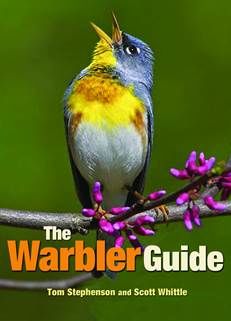The Warbler Guide by Tom Stephenson & Scott Whittle. Drawings by Catherine Hamilton. Princeton University Press, Princeton and Oxford, 560 pp. ISBN: 9780691154824.
“It is perhaps important to start this review with an introductory note. I am a bird watcher from Malaysia, hence I know Malaysian birds well. Due to the large migration to my region, I also know Asian birds well. I have been to the USA twice and Canada once but did not get the opportunity to do much bird watching. I however have been watching birds for 39 years and actively spend my time writing, taking images and posting on birds. This review needs to be read with these constraints in mind.
“I received the book on a Saturday afternoon and dived immediately into it. 560 pages dedicated to 56 birds was impressive and finding out Tom is a musician only added to the appreciation of the work. I decided first to get a general ‘feel’ of the book, the sections and layout. I was delighted that the authors had spent much time on the ‘introduction’ (24.5% or 137 pages) with many detailed tools to aid in making a ‘diagnosis’.
“Not being familiar with North American Warblers I decided the best thing would be to test the book right away, before even reading it or getting familiar with the various Warblers. The ideal would have been to use it in the field in North America. This being not possible I decided to test myself using the 8 Warblers offered in the ‘Quiz and Review’ section. I wished this section was longer as it made me feel like I was in the field. I read the preliminary description of each bird (Where & What; The Big Picture) but carefully covered/avoided the discussion so as to remain unbiased. I then used the book as though I had seen that bird for myself. The ‘test birds’ selected were not always easy and some images were offered in less than clear postures, which is what we would expect in the field. To my pleasant surprise I identified 6 out of 8 birds accurately the first time round, even the one that was not a warbler! I must add that it did take slightly over an hour for this exercise.
“The large numbers of quick finders (visual finders) in the introduction are an indispensible starting point to identify birds. These offer the birds in a variety of poses and locations that allow for a preliminary narrowing down of the possible birds. To ‘solve’ the quizzes I used the visual finders to narrow down possibilities and then looked at the description (Species Accounts) offered on each of the possible birds I had short listed. I used the wonderful opportunity to view addition images of each bird, key descriptive points, age and sex variations to help decide. Bird number 4 in the quiz was a crisis, a drab bird with subtle variation in plumage/features. After finding the general group of birds, I found the ‘Comparison Species’ images in the Species Accounts excellent in offering a differential diagnosis (to use medical language) to aid identification. Quiz 5 was a real challenge as the location threw me off (a vagrant) and number 8 was really tough as well.
“After trying out these I went online and tried another North American Warbler quiz LINK. I ignored any scientific names or choices provided and applied the guide. Within 30 minutes I had identified 18 out of the 20 images offered.
“It is important to note that, in making the above identifications, I had yet to use the excellent details on bird calls/songs and sonograms. These would have greatly aided my identification of Warblers in the field. The only minor criticism I have of the guide is the limited information on bird behavior in the Species Accounts.
“Was I living or visiting North America, The Warbler Guide would be an indispensible aid to support the identification of Warblers. It is intelligent, intuitive and, best of all, works wonderfully. It has significantly raised the standard of bird identification guides and has pointed the way forward for other bird guide authors to follow. I have also learned more on bird observation for my own region just by reading it. My only wish is that we had a similar guide for my region.”
Dato’ Dr Amar-Singh HSS
Ipoh City, Perak, Malaysia
August 2013
About the reviewer:
Dr. Amar-Singh HSS is a senior consultant paediatrician with the Ministry of Health Malaysia. He heads a regional paediatric department and a regional research centre. He has been watching birds for 38 years and has published a book on local birds “A Friendship with Birds (A Guide to the Identification & Appreciation of Common Birds in the Gardens & Cities of Peninsular Malaysia). He has published a few articles in Birding Asia, and been a regular contributor to the ‘Bird Ecology Study Group’ and ‘Oriental Bird Images’ bird sites.










2 Responses
Dear Dr. Amar-Singh,
I really enjoyed reading your review. And, since your avifauna unfortunately doesn’t include our beautiful species, your method of testing the book’s effectiveness was very ingenious!
I hope you can some day arrange a trip to the US during warbler migration season. I would enjoy birding with you in our great migration stopovers in New York!
Best regards,
Tom
Dear Tom
I fear I did not do justice to your & Scott’s book.
It is the most imaginative and progressive guide I have seen to date.
Those who have read my review but not seen it may not appreciate the effort put it, the extensive tools and the ‘art/craft’.
I particularly did not do justice to the extensive work put in for the sonograms and bird calls. We have much to learn form your & Scott’s approach in this area.
To enhance the review, can I suggest we add images from the book on visual finders,comparison species and sonograms.
Appreciate the offer to watch birds together.
blessings
Amar